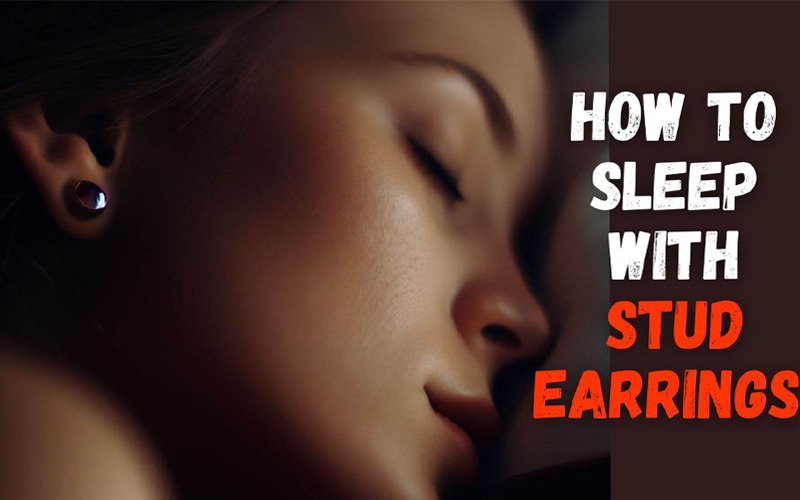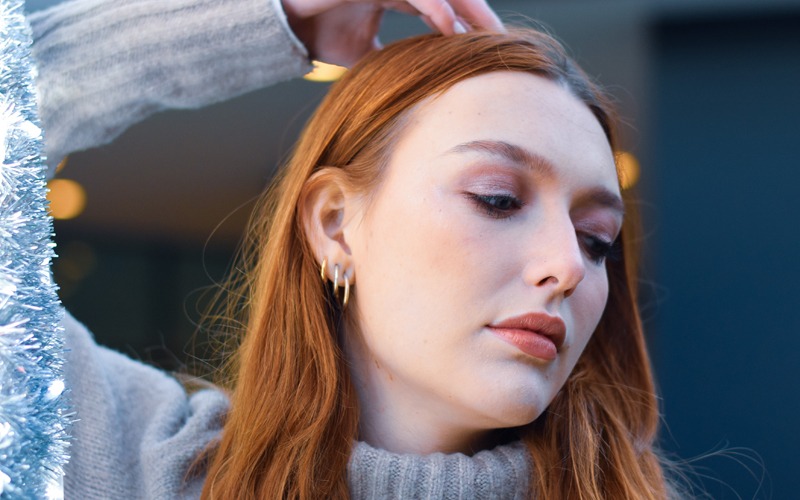Earring closures are an essential component of jewelry design, serving both functional and aesthetic purposes. They not only secure earrings in place but also contribute to their overall style and comfort.
There are several types of earring closures, each with its unique attributes. From the classic and secure screw-backs to the elegant lever-backs, and the versatile and easy-to-wear studs with friction backs, these closures offer diverse options for jewelry enthusiasts.
Magnetic closures provide convenience, while clip-ons cater to non-pierced ears. Understanding these closure types helps individuals choose earrings that match their style, comfort, and functionality preferences.
What Are The Different Types Of Earring Closures
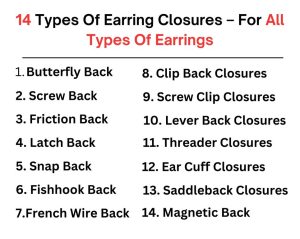
Today in this article we will show you different types of closures for earrings. Here we included different kinds of earring closures for different types of earring styles.
Types Of Stud Earring Closures:
Stud earrings commonly use a butterfly back, friction back, or a screw back closure to secure them in place on the earlobe. There are mainly 3 types of stud earring closures are available, and here are these:
1. Butterfly Back:
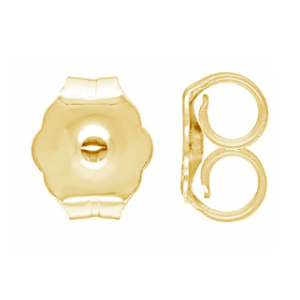
The butterfly back, also known as a butterfly clutch or push back, is a common earring closure style primarily used with stud earrings. It consists of a small, flat metal piece with two wings resembling a butterfly, which can be easily pressed against the earring post to secure it in place.
Butterfly backs are prized for their simplicity and user-friendliness, making them an ideal choice for both casual and formal wear. They are typically comfortable to wear and are available in various materials, including hypoallergenic options for those with sensitive skin.
Butterfly back closures are considered as the safest earring closure for stud or starter earrings. But sometimes you may feel difficulty taking butterfly backs. But we do have an article where we explained how you can take off starter earrings with butterfly backs.
However, occasional checks and tightening may be necessary to prevent them from becoming loose over time.
2. Screw Back:
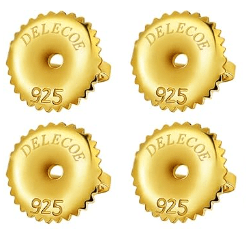
Screw-back earrings feature a secure and distinctive closure mechanism, especially favored for valuable earrings. They comprise a threaded post and a screw-on back, requiring the wearer to twist the back onto the post to secure the earring firmly in place.
This design offers a high level of security, minimizing the risk of accidental loss, making them ideal for expensive or sentimental earrings. While screw-back closures provide exceptional peace of mind, they may require a bit more effort to put on and take off compared to simpler closure types like butterfly backs.
Nonetheless, their reliability and steadfast hold make them a popular choice for earrings that you want to ensure remain securely fastened.
3. Friction Back:
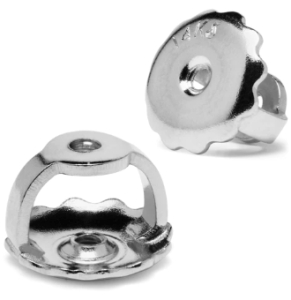
Friction back is a type of earring fastening mechanism commonly used to secure stud earrings in place. It consists of a small metal piece with a textured or grooved surface on one side that creates friction when pressed against the earlobe.
The opposite side typically has a post that passes through the ear piercing and attaches to the earring. The friction created between the textured surface and the earlobe helps keep the earring in position, preventing it from slipping or falling off.
Friction backs are popular for their simplicity and ease of use, making them a practical choice for everyday earrings.
Types Of Hoop Earring Closures:
Hoop earring closures often use latch-back or snap closures to secure the earrings in place. These are the two main types of closures for hoop earrings:
4. Latch Back:

A latch back closure is a secure and convenient fastening mechanism commonly used for earrings. It consists of a hinged lever that can be easily flipped up or down to open or close the earring.
When the lever is lifted, it releases the earring from the post, allowing it to be inserted into or removed from the earlobe hole. Once the earring is in place, the lever is pushed down, creating a snug and reliable hold that keeps the earring securely in position.
Latch-back closures are favored for their user-friendly design, providing both ease of use and enhanced security, making them a popular choice for various earring styles.
5. Snap Closure:
Snap closure is a straightforward and effective fastening mechanism commonly utilized in various accessories, such as handbags, wallets, and jewelry, to securely close and open them.
It typically involves two complementary components: a male and a female part. To fasten, the male portion, often a small protruding knob or button, is pressed firmly into the corresponding female component, which is equipped with a receptacle or socket.
The “snap” occurs when the two pieces audibly and securely connect, providing a reliable closure. Snap closures are appreciated for their simplicity, durability, and ease of use, making them a versatile choice for a wide range of applications, from fashion to functional accessories.
Types Of Hook Earring Closures:
Hook earring closures are a type of fastening mechanism featuring a curved wire or hook that threads through the earlobe piercing, often used for dangle earrings. Fish hook and French wire are the two main types of hook earring closures.
6. Fishhook:
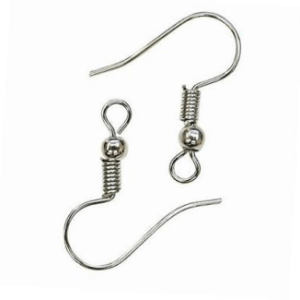
A fishhook closure is a common fastening mechanism used in jewelry, particularly for dangling earrings. It consists of a long, curved wire that resembles a fishhook. One end of the wire forms the decorative or beaded portion of the earring.
While the other end features a small loop or eyelet that allows it to be attached to the earlobe. To wear fishhook earrings, the curved end is threaded through the ear piercing, and the earring dangles freely.
The open design of fishhook closures offers flexibility and ease of use but may require additional rubber stoppers or backs to prevent the earrings from slipping out.
7. French Wire:

A French wire closure, also known as a bullion or gimp, is a traditional and elegant earring fastening method commonly used in jewelry design. It consists of a thin, flexible wire that threads through the pierced earlobe, securing the earring in place.
The wire is often made of fine metal, like gold or silver, and can be adorned with decorative elements like beads or crystals. French wire closures provide a delicate and flowing appearance to earrings, with the wire gracefully draping behind the ear.
While they add a touch of sophistication to earrings, they may require additional silicone or rubber earring backs to ensure a secure fit and prevent accidental loss.
Types Of Clip-On Earring Closures:
Clip-on earring closures are mechanisms that secure earrings to the earlobe without the need for piercing, using a clamping or squeezing action. Clip backs and screw clips are the common types of earring closures for clip-on earrings.
8. Clip Back:
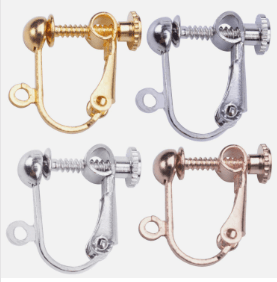
A clip-back closure is a type of earring fastening mechanism designed for non-pierced ears. It consists of a hinged metal clip that can be opened and closed manually.
The clip-back earring is equipped with a cushioned pad or rubber lining on the back of the clip, providing comfort and grip against the earlobe. To wear clip-back earrings, one simply presses the clip open, positions it onto the earlobe, and then gently releases it to secure the earring in place.
Clip-back closures are favored for their versatility, allowing individuals without ear piercings to enjoy a wide range of earring styles, from classic to statement designs.
9. Screw Clip:
A screw clip closure is a type of earring fastening mechanism designed for non-pierced ears. It combines the features of a screw-back earring and a clip-on earring to provide a secure and adjustable fit. The closure typically consists of a threaded post and a hinged clip.
To wear these earrings, one screws the post into the clip, adjusting the tightness to fit comfortably on the earlobe.
The screw clip closure offers a reliable hold, making it an excellent choice for those who prefer clip-on earrings but want the added security of screw-back earrings. This versatile closure ensures both comfort and stability for a wide range of earring styles.
Types Of Leverback Earring Closures:
Leverback earring closures are a secure and elegant fastening mechanism characterized by a hinged lever that attaches to the earlobe, providing both style and reliability. Let’s see what types of lever back earring closures are available.
10. Lever Back:
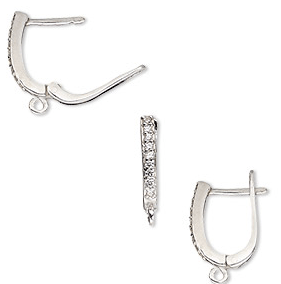
A lever-back closure is a popular earring fastening mechanism known for its security and aesthetic appeal. It consists of a hinged lever attached to the earring, typically a hoop or a hook, which is designed to pass through the earlobe piercing.
To wear lever-back earrings, the lever is lifted, allowing the earring to be inserted into the earlobe hole, and then the lever is lowered, securing the earring in place. The design ensures a snug and comfortable fit while minimizing the risk of the earring slipping off.
Lever-back closures are widely used for various earring styles, offering both style and reliability to jewelry enthusiasts.
Types Of Threader Earring Closures:
Threader earring closures consist of a thin, flexible chain or wire that threads through the earlobe piercing, allowing for adjustable and customizable earring lengths. Threader closure is the most suitable type of earring closure for threader earrings.
11. Threader:
A threader closure is a versatile and unique earring fastening mechanism appreciated for its simplicity and customizable fit. It consists of a thin, flexible chain or wire, typically made of precious metal, that threads through the earlobe piercing.
One end of the chain may feature a decorative element, while the other end remains plain. To wear threader earrings, the chain is delicately passed through the earlobe, allowing wearers to adjust the length to their preference, creating a stylish and customized look.
Threader closures offer a lightweight and elegant alternative to traditional earring fasteners, making them a popular choice for those seeking a minimalist and adjustable e
Types Of Cuff Earring Closures:
Cuff earring closures are typically open-ended and designed to slide onto the ear’s cartilage, allowing them to comfortably and stylishly encircle the ear. Types of cuff earring closures:
12. Ear Cuff:
An ear cuff closure is a modern and trendy earring style designed to comfortably encircle the outer ear without the need for a traditional piercing. These cuffs typically have an open or slightly adjustable design, allowing them to fit various ear shapes and sizes.
To wear an ear cuff, it is gently squeezed or opened to secure it in place along the ear’s cartilage. Ear cuffs often come in various designs, ranging from simple, sleek bands to intricate, embellished pieces, offering wearers a versatile way to accessorize their ears without permanent piercings. They have gained popularity for their edgy and fashionable appearance.
Types Of Saddleback Earring Closures:
Saddleback earring closures are a type of hinged mechanism that secures earrings, often hoops or hoops-like designs, by folding over a metal bar to create a snug fit. Let’s see how many types of closures are available for saddleback earrings.
13. Saddleback:
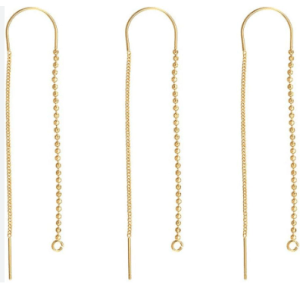
A saddleback closure is a distinctive and secure fastening mechanism frequently used in jewelry, particularly for bracelets and bangles. It is characterized by a curved metal bar that resembles a saddle, with one end featuring a clasp or catch, while the other end is left open.
To secure the jewelry piece, the open end of the saddleback is positioned over a corresponding catch, creating a snug fit that prevents the item from slipping off the wrist.
Saddleback closures are favored for their elegant and streamlined design, offering both style and reliability, making them a popular choice for various types of bracelets and bangles.
Types Of Magnetic Earring Closures:
Magnetic earring closures are fastening mechanisms that use magnets to securely attach earrings without the need for traditional piercings or clasps. Basically, magnetic backs are the most suitable types of backs for magnetic earrings.
14. Magnetic Back:
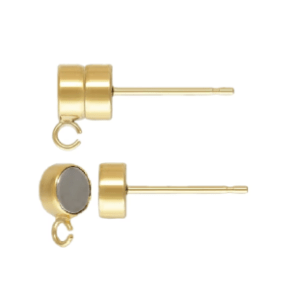
A magnetic back closure is a convenient and innovative fastening mechanism commonly used in various jewelry items, such as necklaces, bracelets, and earrings. It relies on the power of magnets to secure the jewelry in place.
The closure typically consists of two pieces: one with a magnet and the other with a metal surface that the magnet is attracted to. When these pieces come into contact, they create a strong magnetic connection, ensuring the jewelry stays put.
Magnetic closures are praised for their ease of use, especially for individuals with dexterity issues, and they offer a sleek and seamless appearance without visible clasps or hooks. However, they can be less secure than traditional
What Is The Most Common Type Of Earring Closure
The most common type of earring closure is the stud earring closure, also known as butterfly backs or push-backs. This ubiquitous closure mechanism is favored for its simplicity, versatility, and widespread appeal.
Stud earrings consist of a straight post, typically made of metal like gold, silver, or stainless steel, that passes through the earlobe.
On the opposite side of the post, there’s a small, flat backing resembling a butterfly’s wings, which holds the earring in place. The name “butterfly backs” comes from the shape and design of this securing element.
What makes stud earrings so popular is their ease of use. To wear them, you insert the post through your earlobe piercing, and then you attach the butterfly back, which provides a snug and secure fit.
This closure type is known for its comfort and stability, making it suitable for both casual and formal occasions.
Stud earrings come in an extensive range of styles and materials, from classic diamond or pearl studs to colorful gemstone studs and creative, contemporary designs.
This versatility allows people to express their individuality and match their earrings to various outfits and occasions.
Overall, the stud earring closure’s timeless elegance and practicality have solidified its status as the most common and widely loved type of earring closure in the world of jewelry.
Which Earring Closure Type Is Best For Sensitive Ears
For individuals with sensitive ears, it’s essential to choose earring closure types that minimize irritation and discomfort. The best earring closure type for sensitive ears is typically the threader closure or lever-back closure.
1. Threader Closure:
Threader earrings use a thin chain or wire that threads through the earlobe piercing. Because they lack bulky posts and backs, they are lightweight and reduce the risk of irritation.
Threader closures provide minimal contact with the skin, making them a comfortable option for those with sensitivities.
2. Lever-Back Closure:
Lever-back closures have a hinged lever that securely holds the earring in place. They are less likely to pinch or irritate the earlobe compared to some other closures like butterfly backs or clip-on.
Lever-backs offer both security and comfort, making them suitable for sensitive ears.
Remember one thing, threader or lever-back whatever you choose for your sensitive ears, make sure that your earring closures are hypoallergenic. Yes, a good pair of hypoallergenic earring closures can be the best option for you if you have sensitive skin.
Frequently Asked Questions
Q: How do screw-back earrings work?
A: Screw-back earrings have a threaded post that twists into a matching threaded hole on the earring back. To wear them, you gently rotate the earring’s post into the hole, adjusting the tightness for comfort. This secure screw mechanism ensures the earring remains in place and is ideal for heavy or valuable earrings.
Q: Are friction backs secure for everyday wear?
A: Friction backs, while suitable for everyday wear, may not be as secure as screw-backs or other closures. They rely on friction to hold earrings in place, which can be less stable and might require occasional adjustments to prevent accidental loss.
Q: What are La Pousette’s backs, and why are they popular?
A: La Pousette backs are a type of earring closure known for their security and ease of use. They feature a spring-loaded mechanism that locks the earring securely in place, reducing the risk of accidental loss. Their popularity stems from the combination of comfort, reliability, and convenience they offer.
Q: Can you convert stud earrings with butterfly backs to screw backs?
A: Converting stud earrings with butterfly backs to screw backs is possible but requires professional jeweler assistance as it involves modifying the earring post and adding a threaded component.
Q: Do all hoop earrings use latch-back closures?
A: No, not all hoop earrings use latch-back closures. Hoop earrings can have various closure types, including latch-backs, hinged snap closures, or even simple wire threads. The choice of closure depends on the design and style of the earrings.
Q: How do you secure threader earrings in place?
A: Threader earrings are secured by threading the thin chain or wire through the earlobe piercing. To keep them in place, gently adjust the length of the chain, ensuring it fits comfortably and doesn’t pull or tug on the earlobe.
Q: Are magnetic earrings secure, and do they work for non-pierced ears?
A: Magnetic earrings can be secure for non-pierced ears but are generally less secure than other closures. They work by attracting to the earlobe through magnetic force. However, they may occasionally detach, so caution is advised.
Q: What is the difference between leverback and latch-back earrings?
A: Leverback and latch-back earrings are similar but differ in their closure mechanisms. Leverbacks have a hinged lever that secures the earring in place when lifted and closed. Latch-backs, on the other hand, feature a small, spring-loaded latch that snaps into place when the earring is inserted. Both offer security and style options.
Q: Are there earring closure options for people with arthritis or limited dexterity?
A: Yes, there are earring closure options designed for individuals with arthritis or limited dexterity, such as magnetic closures, clip-ons, and lever-backs, which are easier to manipulate than traditional earring closures like butterfly or screw-backs.
Q: What is the purpose of safety screw-on screw-back earrings?
A: The safety screw-on screw-back earrings provide an extra layer of security to prevent accidental loss. It ensures that the earring remains firmly in place by creating a threaded, snug fit between the earring post and the backing.
Final Words
In conclusion, here we described about 14 different types of earring closures that are suitable and usable for all types of earrings. Additionally, the world of earring closures offers a diverse array of options to cater to individual preferences, style choices, and practical needs.
From the timeless elegance of screw-backs and lever-backs to the convenience of magnetic closures and clip-ons, each type serves a unique purpose. Threader closures allow for customization, while friction backs offer simplicity.
The choice of closure depends on factors like comfort, security, and personal style. Ultimately, understanding these earring closure types empowers individuals to make informed choices, ensuring their earrings not only adorn but also provide the desired level of comfort and reliability in everyday wear or for special occasions.



